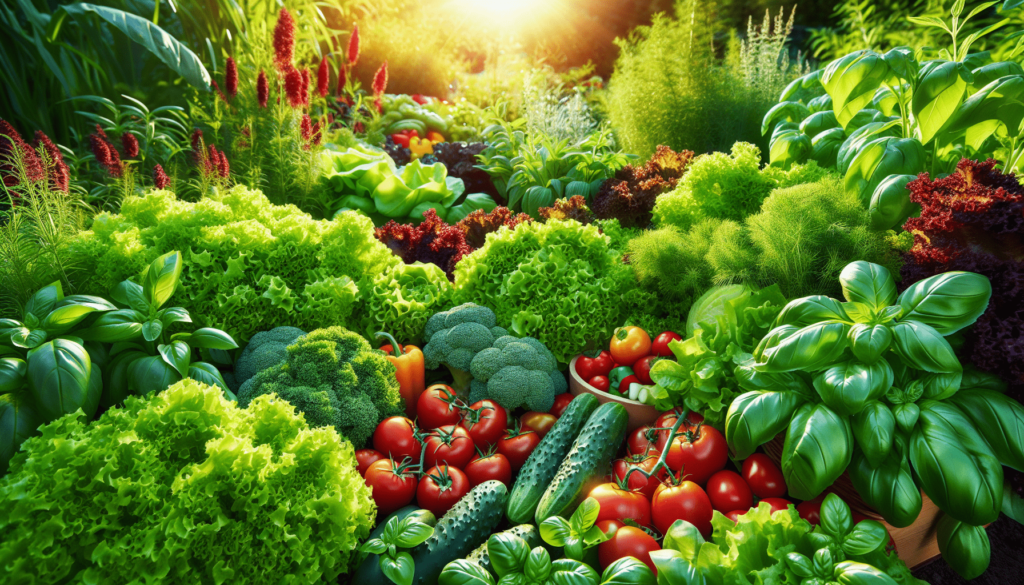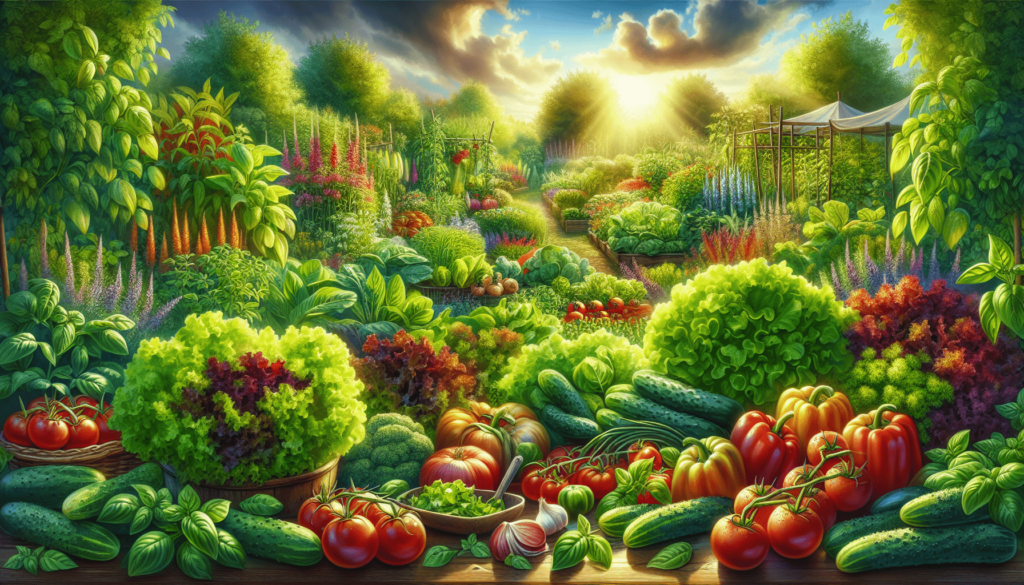Are you looking to add some fresh greens to your meals? Why not try growing a salad garden right at your fingertips! With just a little bit of time and effort, you can enjoy the convenience and satisfaction of picking your own lettuce, spinach, and other delicious salad ingredients straight from your backyard. Imagine the joy of creating a healthy and tasty meal using ingredients you grew yourself. So roll up your sleeves, grab your gardening gloves, and get ready to cultivate your very own salad garden! Have you ever dreamed of having a constant supply of fresh, delicious salad greens right at your fingertips? With a salad garden, you can make that dream a reality! Imagine being able to step outside your door and pick the perfect ingredients for a healthy and satisfying meal.
Getting Started with Your Salad Garden
Planting a salad garden is easier than you might think. All you need is a sunny spot in your yard or on a balcony, some containers or raised beds, soil, seeds, and a little bit of patience. You can even start small with just a few containers and expand as you become more comfortable with gardening.
Choosing the Right Location
The first step in starting your salad garden is choosing the right location. Most salad greens thrive in full sun, so look for a spot in your yard or balcony that receives at least 6-8 hours of sunlight per day. If you don’t have a sunny spot, don’t worry; there are plenty of greens that can tolerate partial shade.
Selecting Containers or Raised Beds
If you have limited space or poor soil quality, containers or raised beds are a great option for your salad garden. Choose containers that are at least 6-12 inches deep to give your plants plenty of room to grow. Raised beds are another excellent choice, especially if you have poor drainage or soil quality in your yard.
Choosing the Right Soil
Good soil is the key to a successful salad garden. Look for a high-quality potting mix that is well-draining and rich in organic matter. Avoid using garden soil, as it can contain pests, diseases, and weed seeds. You can also make your own potting mix using a combination of compost, peat moss, and perlite or vermiculite.
Selecting the Perfect Seeds
When it comes to selecting seeds for your salad garden, the possibilities are endless. Choose a variety of greens that you enjoy eating, such as lettuce, spinach, arugula, kale, and Swiss chard. Consider planting a mix of colors, textures, and flavors to keep your salads interesting and delicious.
Planting Your Salad Garden
Once you have all of your supplies ready, it’s time to start planting your salad garden. Follow these simple steps to get your garden off to a healthy and productive start.
Planting Seeds
Start by filling your containers or raised beds with soil, leaving a few inches of space at the top. Sprinkle your seeds evenly over the soil surface, following the planting instructions on the seed packet. Cover the seeds lightly with soil, water gently, and keep the soil consistently moist until the seeds germinate.
Thinning Seedlings
Once your seeds have germinated and the seedlings have a few true leaves, it’s time to thin them out. Crowded plants compete for resources like water, sunlight, and nutrients, so it’s essential to give them some space to grow. Use scissors to snip off the weakest seedlings at the soil line, leaving the healthiest and strongest plants behind.
Watering and Fertilizing
Salad greens need consistent moisture to thrive, so make sure to water your garden regularly, especially during hot and dry weather. Use a watering can or hose with a gentle spray to avoid damaging delicate seedlings. You can also fertilize your plants every couple of weeks with a balanced organic fertilizer to encourage healthy growth and productivity.
Pruning and Harvesting
As your salad garden grows, you’ll need to keep an eye on your plants and make sure they’re not overcrowded. Use scissors to prune any yellowing or damaged leaves, and harvest your greens when they reach a size that you find appealing. Regular harvesting encourages new growth and extends the life of your plants.

Caring for Your Salad Garden
Caring for your salad garden doesn’t have to be difficult. With a little bit of knowledge and attention, you can keep your plants healthy and productive all season long.
Pests and Diseases
One of the most common challenges in salad gardening is dealing with pests and diseases. Keep an eye out for common problems like aphids, snails, slugs, and powdery mildew, and take steps to address them before they become a serious issue. You can use natural pest control methods like hand-picking, insecticidal soap, beer traps, and companion planting to keep your garden healthy and pest-free.
Weeding
Weeds can quickly take over your salad garden and compete with your plants for essential resources. Keep on top of weeding by pulling out any unwanted plants as soon as you see them. You can also use mulch to suppress weeds and retain moisture in the soil, making your garden more resistant to dry spells.
Companion Planting
Companion planting is a great way to naturally deter pests, attract beneficial insects, and improve the overall health of your salad garden. Consider planting herbs like basil, cilantro, dill, and parsley alongside your greens to repel pests and add flavor to your salads. You can also grow flowers like marigolds, nasturtiums, and calendula to attract pollinators and beneficial insects.
Season Extension
If you live in a region with a short growing season, you can extend the harvest of your salad garden by using row covers, cold frames, or cloches. These simple tools help protect your plants from frost and cold temperatures, allowing you to enjoy fresh greens well into the fall and winter months. You can also choose cold-hardy greens like kale, collards, and mustards that can withstand colder temperatures.
Enjoying Your Fresh Greens
After all of your hard work and dedication, it’s time to enjoy the fruits of your labor. Whether you’re tossing them into a salad, juicing them, blending them into smoothies, or using them in soups and stir-fries, fresh greens are a versatile and nutritious addition to any meal.
Salad Recipes
There are endless possibilities when it comes to salad recipes, so don’t be afraid to get creative in the kitchen. Mix and match your favorite greens with toppings like nuts, seeds, dried fruit, cheese, and protein sources like chicken, tofu, or beans. Experiment with different dressings and vinaigrettes to find the perfect combination that suits your taste buds.
Juicing and Smoothies
Fresh greens are a fantastic addition to homemade juices and smoothies, providing a burst of vitamins, minerals, and antioxidants that nourish your body from the inside out. Try blending spinach, kale, cucumber, apple, lemon, and ginger for a refreshing green juice, or mix up a tropical smoothie with kale, pineapple, mango, and coconut water.
Cooking with Greens
Greens are not just for salads; they can also be cooked in a variety of dishes for added flavor, color, and nutrition. Try sautéing spinach with garlic and olive oil, roasting kale chips with sea salt and nutritional yeast, or adding Swiss chard to pasta dishes and frittatas. The possibilities are endless when it comes to cooking with fresh greens.

Conclusion
Growing a salad garden is a rewarding and fulfilling experience that allows you to connect with nature, nourish your body, and savor the simple pleasure of picking your own food. By following the tips and techniques outlined in this article, you can cultivate a vibrant and abundant salad garden that provides you with fresh greens at your fingertips all season long. So what are you waiting for? Start your salad garden today and enjoy the taste of homegrown goodness in every bite.

